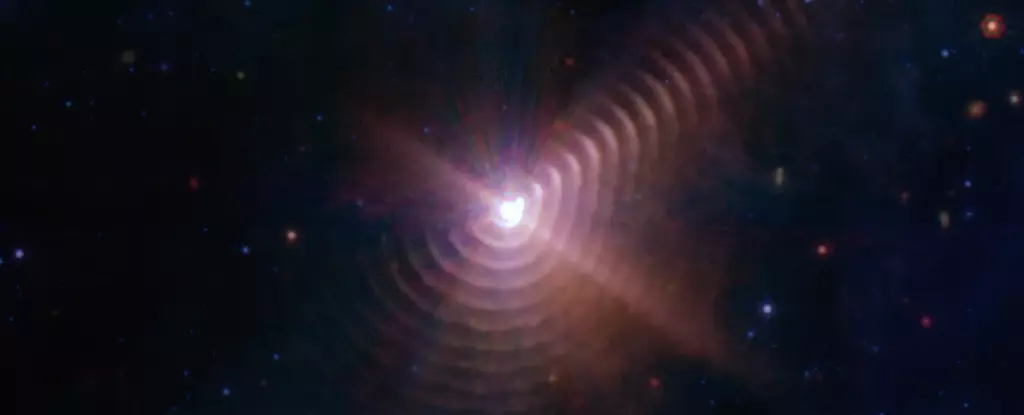Carbon, the fundamental building block of life, is not merely a terrestrial element; it is an essential player in the cosmic story of creation. Carbon-rich cosmic dust originates from various sources in the universe and disperses throughout space, playing a crucial role in the formation of rocky planets and, ultimately, life as we know it. The delicate balance between visibility and obscuration of celestial objects comes into play when astronomers direct their telescopes toward the cosmos, as cosmic dust often obscures the very targets they seek to study. In a bid to penetrate these shrouds of dust, the James Webb Space Telescope (JWST) has been utilized for its infrared capabilities, revealing insights into complex astrophysical phenomena.
The Wolf-Rayet binary system WR 140, situated approximately 5,000 light-years away in the constellation Cygnus, serves as a fascinating laboratory for studying cosmic dust production. A recent study published in Nature Astronomy has shed light on this intricate binary system, focusing on how its stellar winds collide to generate rings of carbon-rich dust. These winds create an environment that is not just energetic but also tumultuous, indicating that the conditions near WR 140 could lead to significant chemical reactions influencing the genesis of carbonaceous materials.
Researchers revealed that the gas produced by the collision of winds from both stars creates discrete rings of dust that expand outward. The cyclical nature of this dust generation occurs every 7.93 years as the binary reaches its periastron—the point at which the two stars are closest to one another. By studying this system, scientists hope to unravel the complexities of dust formation and its roles in the interstellar medium’s chemical enrichment.
The nuclear furnace of these massive stars produces winds that are not only energetic but laden with intricate chemical compositions. When the wind from the more massive Wolf-Rayet star collides with that of its companion OB star, conditions arise that compress the gas and facilitate dust formation. This chaotic atmosphere, with its blend of intense gravitational forces and energetic emissions, makes WR 140 a rare specimen for observing these phenomena. While many binary systems exist in the galaxy, few are as dynamic as WR 140, making it invaluable for scientific exploration.
Observations over the past few decades have illustrated how the orbit of the binary system corresponds with the formation of dust, leading researchers to view these dust-producing stars as potential sources of significant cosmic materials. The ability of JWST to capture imagery of WR 140—both during the initial and subsequent encounters—is providing astronomers unparalleled insights into the nature of dust formation over crucial time frames.
In a universe often perceived as a slow-moving expanse where processes take millions or billions of years, the observable behavior of WR 140’s dust formation challenges this concept. Only 14 months separated JWST’s first and second look at this celestial duo, yet astronomers noted significant expansion of the dust rings in that brief period. This rapid dynamism in the expansion of dust shells presents findings that could enrich our understanding of stellar evolution and the life cycle of cosmic materials.
This short-term insight into the dynamic evolution of the dust rings not only redefines how we regard astronomical phenomena but also emphasizes the potential of massive binary systems like WR 140 as factories for producing fundamental cosmic elements. The intricacies of cosmic dust, from massive clouds to finer particles, underline the complexity of astrobiological processes at play.
With JWST’s powerful instruments, including its Mid-Infrared Instrument (MIRI), astronomers are equipped to study the vast expanse of dusty shells that extend well beyond what previous observatories could capture. Each shell, estimated to yield a distance of approximately 1.4 trillion kilometers apart, is a testament to the system’s long-term dust-generating capability. Researchers have projected that WR 140 will continue to produce thousands of dust shells over the coming millennia, enriching our cosmic understanding.
As stellar evolution unfolds, the eventual fate of WR 140 will also be significant. The transition of Wolf-Rayet stars into supernovae or black holes is a subject of great interest and will be the focus of future observations, providing deeper insights into the life cycles of stars and their contributions to the interstellar ecosystem.
The revelations surrounding WR 140 underscore the complexity and interconnectedness of cosmic phenomena. As astronomers peer into the heavens with more advanced tools like JWST, our understanding of the universe continues to evolve. The study of WR 140 not only sheds light on the nature of carbon-rich dust but also opens up the possibility to explore the rich tapestry of creation, revealing the fundamental processes that may have influenced the emergence of life. The journey into the cosmos is far from over, and with each observation, the universe’s mysteries deepen, revealing stories waiting to be told.


Leave a Reply